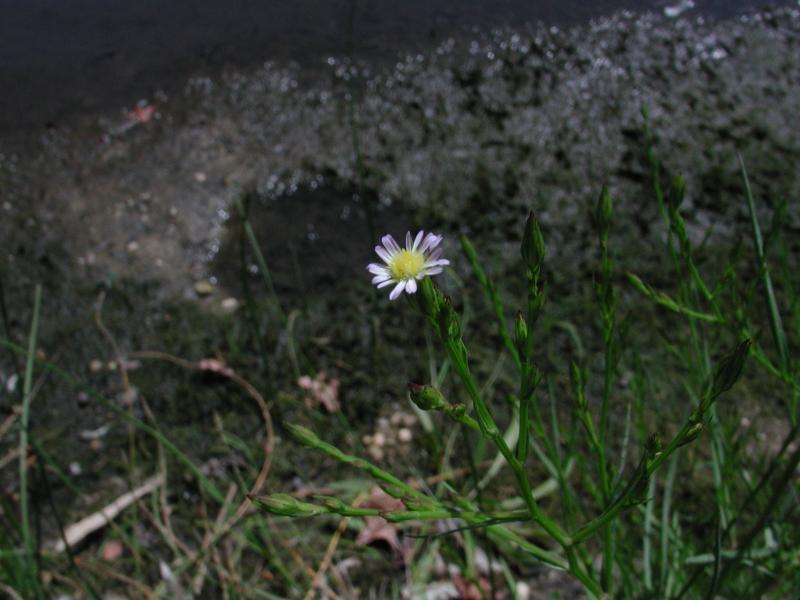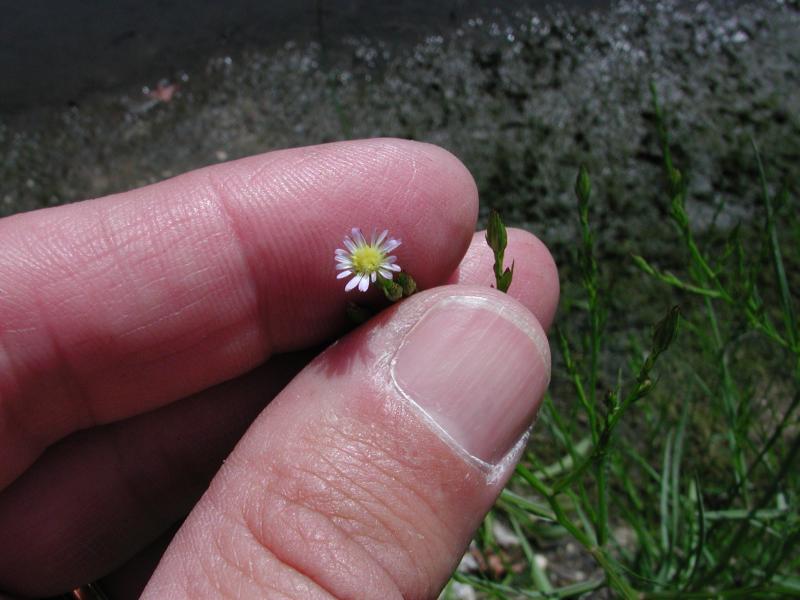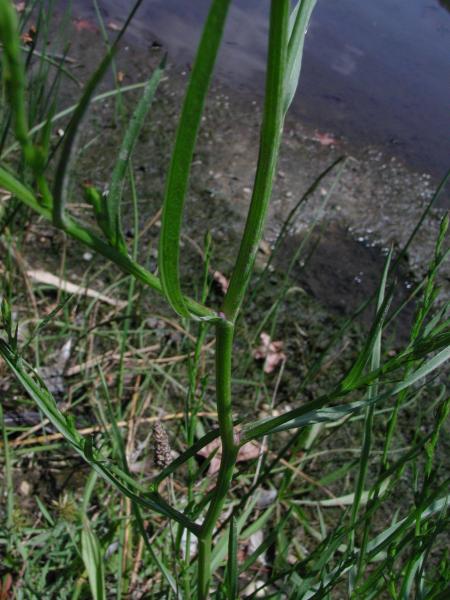Annual Saltmarsh Aster
Symphyotrichum subulatum var. subulatum None
- Class
- Dicotyledoneae (Dicots)
- Family
- Asteraceae (Aster Family)
- State Protection
- Threatened
Listed as Threatened by New York State: likely to become Endangered in the foreseeable future. For animals, taking, importation, transportation, or possession is prohibited, except under license or permit. For plants, removal or damage without the consent of the landowner is prohibited.
- Federal Protection
- Not Listed
- State Conservation Status Rank
- S2S3
Imperiled or Vulnerable in New York - Very vulnerable, or vulnerable, to disappearing from New York, due to rarity or other factors; typically 6 to 80 populations or locations in New York, few individuals, restricted range, few remaining acres (or miles of stream), and/or recent and widespread declines. More information is needed to assign either S2 or S3.
- Global Conservation Status Rank
- G5T5
Secure globally - Both the species as a whole and the subspecies/variety are common in the world; widespread and abundant (but may be rare in some parts of its range).
Summary
Did you know?
Saltmarsh aster is the only native aster in New York which is an annual (Brouillet et al. 2006). The scientific name subulatum means awl-shaped (Fernald 1970) and is perhaps in reference to the shape of the involucral bracts.
State Ranking Justification
There are currently 13 known extant populations. At least an additonal 18 populations have not been seen in recent years and are considered historical. One population is believed to have been extirpated due to habitat destruction. Some of the historical populations occur in and around the New York City metropolitan area and have likely been extirpated. Overall, the habitat for this species is limited in New York and much of this habitat has been damaged or destroyed.
Short-term Trends
One population has become extirpated within the past 20 years. There is very little other data available to indicate what the short-term trends are for this species in New York. Overall, it appears that this species may be at least slightly declining in recent years.
Long-term Trends
At least one population in New York has become extirpated. At least an additional 18 populations have not been seen in recent years. Many of these historical populations are from around the New York City metropolitan area and have likely become extirpated. Some of the historical populations may still be extant but simply have not been searched for recently. At least five out of the 13 extant populations are very small in numbers with 50 or fewer individuals in the populations. While populations of this species may naturally be small these very low numbers for an annual may indicate that these populations are declining. Overall, this species appears to have declined in the past 100+ years.
Conservation and Management
Threats
Populations are threatened or potentially threatened by competition from the non-native invasive common reed (Phragmites australis ssp. australis) and to a lesser degree purple loosestrife (Lythrum salicaria). Ditching of salt marshes, alteration of hydrology, deer browsing, and habitat destruction are also potential and/or current threats.
Conservation Strategies and Management Practices
The invasive common reed should be controlled and deer populations should be reduced to historical levels. Salt and brackish marshes should be protected from human-created disturbances such as ditching or development.
Research Needs
Populations that are only known from historical occurrences should be surveyed to determine if they are still extant. Known extant sites need to be periodically monitored and surveyed.
Habitat
Habitat
In New York, Symphyotrichum subulatum occurs in coastal areas in salt to brackish marshes, along banks of salt influenced tidal channels and creeks, shrub dominated salt influenced habitats, edges of salt ponds, wet brackish swales in maritime dunes, and occasionally in disturbed habitats that are salt influenced. Along the lower Hudson River it also occurs in brackish marshes and along brackish tidal drainages sometimes occurring in disturbed habitats adjacent to these marshes. Inland in New York, it is known from inland saltmarshes, edges of artificial salt ponds, and salt storage areas around Syracuse (New York Natural Heritage Program 2007). Salt marshes, brackish marshes, tidal marshes, salted highways, and around salt mines (Brouillet et al. 2006). Coastal mostly saline marshes (Gleason and Cronquist 1991). Saline marshes, brackish to fresh tidal marshes, fresh thickets, borders of woods and clearing inland to the fall-line (Fernald 1970).
Associated Ecological Communities
- Brackish interdunal swales
(guide)
Temporarily tidally flooded temperate marshes in interdunal swales dominated by salt-tolerant graminoids. Individual swales occur as small patches positioned between fore-, primary and secondary dunes in a maritime dunes system, typically on barrier islands.
- Brackish meadow
(guide)
A moist, moderately well-drained brackish (salinity 0.5-18 ppt) perennial grassland with occasional isolated shrubs that is typically situated in a belt at the upper edge of salt marshes bordering sandy uplands, but may occupy large portions of interdunal basins. The community usually develops in areas with a unique combination of soils and hydrology, on deep deposits of periodically windblown or overwashed gleyed sands that are usually flooded only during spring tides and during major coastal storms, approximately two to three times per year.
- Brackish tidal marsh
(guide)
A marsh community that occurs where water salinity ranges from 0.5 to 18.0 ppt, and water is less than 2 m (6 ft) deep at high tide. The vegetation in a brackish tidal marsh is dense and dominated by tall grass-like plants.
- Coastal salt pond
(guide)
A community inhabiting marine shoreline lakes or ponds formed by sandspits that close off a lagoon or bay. The water typically averages brackish or slightly brackish over long periods of time, but may range rapidly from fresh to saline.
- Estuarine riprap/artificial shore
The wetland community of a constructed estuarine shore in which the substrate is composed of broken rocks, wooden bulkheads, or concrete placed so as to reduce erosion. Vegetative cover and species diversity are low compared to natural estuarine shores.
- High salt marsh
(guide)
A coastal marsh community that occurs in sheltered areas of the seacoast, in a zone extending from mean high tide up to the limit of spring tides. It is periodically flooded by spring tides and flood tides. High salt marshes typically consist of a mosaic of patches that are mostly dominated by a single graminoid species.
- Inland salt marsh
(guide)
A wetland that occurs on saline mudflats associated with inland salt springs. The mucky substrate is permanently saturated and seasonally flooded. Plant cover is sparse and the number of different kinds of plants is relatively low.
- Salt shrub
(guide)
A shrubland community that forms the ecotone between salt marsh and upland vegetation. Salinity levels are generally lower here than in the salt marsh (soil pore salinity ranges 7 ppt to 27 ppt), and the elevation is higher. Salt shrub does not usually develop on deep peat. More often, it occurs on a thin (0-10 cm) layer of peat, and soils share characteristics of both estuarine and maritime terrestrial settings.
- Sea level fen
(guide)
A wetland that occurs at the upper edge of salt marshes but is fed primarily by acidic groundwater seeping out along the upland edge. This fresh water sometimes mixes with salt or brackish water during unusually high tides. There is a high abundance of sedges that decompose slowly and create a deep substrate of peat. This peat is underlain by deep sand or gravel. These fens usually have a high diversity of herbs but may also have scattered trees and shrubs.
Associated Species
- Agalinis maritima var. maritima (seaside agalinis)
- Amaranthus cannabinus (salt marsh water-hemp)
- Amaranthus pumilus (sea-beach amaranth, coast amaranth)
- Baccharis halimifolia (groundsel-tree)
- Bolboschoenus maritimus
- Chenopodium rubrum
- Cyperus filicinus (fern flat sedge)
- Distichlis spicata (salt grass)
- Eupatorium serotinum (late thoroughwort)
- Fimbristylis castanea (marsh fimbry)
- Iva frutescens (salt marsh-elder)
- Juncus gerardii
- Juniperus virginiana
- Limonium carolinianum (sea-lavender)
- Panicum virgatum (switch grass)
- Persicaria punctata (dotted smartweed)
- Phragmites australis ssp. australis
- Pluchea odorata (salt marsh-fleabane)
- Polygonum ramosissimum ssp. prolificum (proliferous knotweed)
- Salicornia depressa (slender glasswort)
- Schoenoplectus acutus
- Solidago sempervirens (northern seaside goldenrod)
- Spartina alterniflora (smooth cord grass)
- Spartina patens (salt-meadow cord grass)
- Spergularia salina
- Symphyotrichum ciliatum (rayless alkali-aster)
- Symphyotrichum tenuifolium var. tenuifolium (perennial salt marsh-aster)
- Teucrium canadense (American germander)
Range
New York State Distribution
In New York, Symphyotrichum subulatum occurs along the shores of Long Island west to Brooklyn and Staten Island then north along the edges of the Hudson River to Putnam and Rockland Counties. There is also one disjunct population near Syracuse (New York Natural Heritage Program 2007).
Global Distribution
Symphyotrichum subulatum var. subulatum occurs along the gulf coast from Texas to Florida and then along the Atlantic coast from Florida north to Maine. It is disjunct further north in New Brunswick. It is also apparently native around Syracuse, New York, having been known there since at least 1883. Other inland populations are known west to Nebraska but at least some of these are apparently introductions around salted habitats (Sunderberg 1986, Nesom 2005, Brouillet et al. 2006, New York Natural Heritage Program 2007).
Identification Comments
General Description
Saltmarsh aster is an annual herbaceous plant that grows up to 1 m in height. The stems become branched towards their summits. Its narrow linear leaves are scattered along the stems. Like all members of the sunflower family the "flowers" are actually clusters of numerous small flowers (flower heads). These flower heads occur at the summit of the plants and are composed of yellow disc flowers (the central inner flowers) and white ray flowers (the marginal outer flowers) (Gleason and Cronquist 1991, Brouillet et al. 2006).
Best Life Stage for Proper Identification
Symphyotrichum subulatum is best identified when it is in flower. The underground taproots are useful in its identification and voucher specimens should include these if the population is large enough.
Similar Species
Symphyotrichum tenuifolium var. tenuifolium (perennial saltmarsh aster) is a somewhat similar aster that also grows in salt or brackish marshes in New York. It is in the same subgenus (Astropolium) as S. subulatum. Symphyotrichum subulatum can be distinguished by its annual habit, taproot, fewer disc florets (4-13), and shorter and narrower ray florets (1.3-3.1 mm long x 0.2-0.5 mm wide) vs. perennial habit, rhizomes, more disc florets (25-54), and longer and wider ray florets (4.5-9.5 mm long x 1.2-2.0 mm wide) for S. tenuifolium (Brouillet et al. 2006).
Symphyotrichum ciliatum (rayless annual aster) is a non-native species in New York that occurs in salt-influenced habitats such as roadsides although it may also be found in saltmarshes. Like S. subulatum it is an annual. Symphyotrichum ciliatum differs in its sparsely ciliate involucral bracts, strigose achenes, and lack of ray florets (truly only lacking the ray of the ray florets) vs. non-ciliate involucral bracts, glabrate achenes, and distinct although small ray florets for S. subulatum (Semple et al. 2002, Brouillet et al. 2006).
Best Time to See
Since saltmarsh aster can easily be overlooked when vegetative, the best time to survey for this species is from August through mid-October when it is in flower.
- Flowering
The time of year you would expect to find Annual Saltmarsh Aster flowering in New York.
Annual Saltmarsh Aster Images
Images of Similar Species
Taxonomy
Annual Saltmarsh Aster
Symphyotrichum subulatum var. subulatum None
- Kingdom Plantae
- Phylum Anthophyta
- Class Dicotyledoneae
(Dicots)
- Order Asterales
- Family Asteraceae (Aster Family)
- Order Asterales
- Class Dicotyledoneae
(Dicots)
- Phylum Anthophyta
Additional Common Names
- Annual Saltmarsh American-Aster
- Eastern Annual Saltmarsh Aster
Synonyms
- Aster subulatus Michx.
- Aster subulatus var. euroauster Fern. & Grisc.
- Aster subulatus var. obtusifolius Fern. [From New Brunswick.]
Comments on the Classification
With the realization that the genus Aster sensu lato was polyphyletic, it was divided into numerous segregate genera. The largest segregate genus in North America is Symphyotrichum (Semple et al. 2002). Symphyotrichum subulatum is in the subgenus Astropolium which has a total of 3 species and 8 taxa in North America (Sundberg 1986, Brouillet et al. 2006). Symphyotrichum subulatum is a variable taxon. Some authors (Sundberg 1986, 2004, Brouillet et al. 2006) divide S. subulatum into five varieties while others (Nesom 2005, Weakley 2007) give species status to each of these varieties. Nesom (2005) makes a strong argument to recognize these varieties at the species level. In New York only one taxon, S. subulatum var. subulatum is present (Brouillet et al. 2006).
Additional Resources
Best Identification Reference
Brouillet, L., J.C. Semple, G.A. Allen, K.L. Chambers, and S.D. Sundberg. 2006. Symphyotrichum Nees. Pages 465-539 in Flora of North America Editorial Committee (Editors), Flora of North America, North of Mexico, Volume 20, Magnoliophyta: Asteridae, part 7: Asteraceae, part 2. Oxford University Press, New York, New York, USA.
Other References
Clemants, Steven and Carol Gracie. 2006. Wildflowers in the Field and Forest. A Field Guide to the Northeastern United States. Oxford University Press, New York, NY. 445 pp.
Crow, Garrett E. and C. Barre Hellquist. 2000. Aquatic and Wetland Plants of Northeastern North America: A revised and enlarged edition of Norman C. Fassett's a Manual of Aquatic Plants. Volume One: Pteridophytes, Gymnosperms, and Angiosperms: Dicotyledons. The University of Wisconsin Press. Madison, Wisconsin. 536 Pages.
Fernald, M.L. 1950. Gray's manual of botany. 8th edition. D. Van Nostrand, New York. 1632 pp.
Gleason, Henry A. and A. Cronquist. 1991. Manual of Vascular Plants of Northeastern United States and Adjacent Canada. The New York Botanical Garden, Bronx, New York. 910 pp.
Haines, Arthur and Thomas F. Vining. 1998. Flora of Maine. A Manual for Identification of Native and Naturalized Vascular Plants of Maine.
Holmgren, Noel. 1998. The Illustrated Companion to Gleason and Cronquist's Manual. Illustrations of the Vascular Plants of Northeastern United States and Adjacent Canada. The New York Botanical Garden, Bronx, New York.
Nesom, G.L. 2005. Taxonomy of the Symphyotrichum (Aster) subulatum group and Symphyotrichum (Aster) tenuifolium (Asteraceae: Astereae). Sida 21: 2125-2140.
New York Natural Heritage Program. 2010. Biotics database. New York Natural Heritage Program. New York State Department of Environmental Conservation. Albany, NY.
New York Natural Heritage Program. 2024. New York Natural Heritage Program Databases. Albany, NY.
Newcomb, Lawrence. 1977. Newcomb's Wildflower Guide: An Ingenious New Key System for Quick, Positive Field Identification of the Wildflowers, Flowering Shrubs, and Vines of Northeastern and North-Central North America. Little, Brown and Company. Boston.
Semple, J.C., S.B. Heard, and L. Brouillet. 2002. Cultivated and native asters of Ontario (Compositae: Astereae). University of Waterloo Biology Series 41, Waterloo, Canada. 135 pp.
Sundberg, S.D. 1986. The Systematics of Aster Subgenus Oxytriplium (Compositae) and Historically Allies Species. Ph. D. Dissertation. University of Texas at Austin., Austin, TX, USA.
Sundberg, Scott. 2004. New combinations in North American Symphyotrichum subgenus Astropolium (Asteraceae: Astereae). Sida 21(2): 903-910.
Voss, Edward G. 1996. Michigan Flora Part III. Dicots Concluded (Pyrolaceae - Compositae). Cranbrook Institute of Science Bulletin 61 and University of Michigan Herbarium. 622 pp.
Weakley, A.S. 2007. Flora of the Carolinas, Virginia, Georgia, and surrounding areas. Working draft of 11 January 2007. University of North Carolina Herbarium (NCU), North Carolina Botanical Garden, University of North Carolina at Chapel Hill. [http://www.herbarium.unc.edu/flora.htm (accessed 2007)]
Weldy, T. and D. Werier. 2010. New York flora atlas. [S.M. Landry, K.N. Campbell, and L.D. Mabe (original application development), Florida Center for Community Design and Research http://www.fccdr.usf.edu/. University of South Florida http://www.usf.edu/]. New York Flora Association http://newyork.plantatlas.usf.edu/, Albany, New York
Weldy, Troy W. and David Werier. 2005. New York Flora Atlas. [S.M. Landry, K.N. Campbell, and L.D. Mabe (original application development), Florida Center for Community Design and Research. University of South Florida]. New York Flora Association, Albany, NY. Available on the web at (http://newyork.plantatlas.usf.edu/).
Links
About This Guide
Information for this guide was last updated on: December 30, 2008
Please cite this page as:
New York Natural Heritage Program. 2024.
Online Conservation Guide for
Symphyotrichum subulatum var. subulatum.
Available from: https://guides.nynhp.org/annual-saltmarsh-aster/.
Accessed July 26, 2024.





